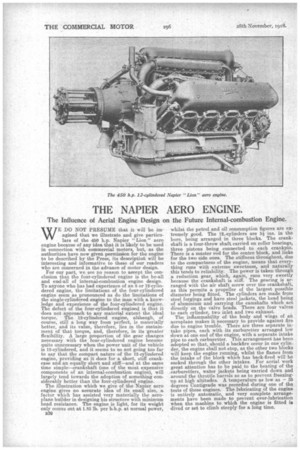THE NAPIER AERO ENGINE.
Page 10

If you've noticed an error in this article please click here to report it so we can fix it.
The Influence of Aerial Engine Design on the Future Internal-combustion Engine.
WE DO NOT PRESUME that it will be imagined that we illustrate and give particulars of the 450 h.p. Napier "Lion aero engine because of any idea that it is likely to be used in connection with commercial motors, but, as the authorities have now given permission for the engine to be described by the Press, its description will be interesting and informative to those of our readers who are concerned in the advance of motor design. For our part, we see no reason to accept the conclusion that the four-cylindered engine is the be-all and end-all of internal-combustion engine design. To anyone who has had experience of an 8 or 12-cylindered engine, the limitations of the four-cylindered engine seem as pronounced as do the limitations of the single-cylinclered engine to the man with a knowledge and experience of the four-cylindered engine. The defect of the four-cylindered engine(' is that it
• does not approach to any material extent the ideal torque. The 12-cylindered engine, although, of course, still a long way from perfect, is materially better, and its value, therefore, lies in the sustainment of that torque, and, therefore, in its greater flexibility. A large proportion of the gear changes necessary with the four-cylindered engine become quite unnecessary when the power unit of the vehicle is 12-cylindered, and it seems to us not going too far to say that the compact nature of the 12-cylindered engine, providing as it does for a short, stiff crankcase and an equally short and stiff—and at the same time simple—crankshaft (one of the most expensive components of an internal-combustion engine), will largely tend towards the adoption of something considerably better than the four-cylindered engine.
The illustration which we give of the Napier aero engine gives no accurate idea of its small size, a. factor which has assisted very materially the aeroplane builder in designing his structure with minimum head resistance. The engine is light, for its weight only comes out at 1.85 lb. per b.h.p. at normal power, 330 whilst the petrol and oil consumption figures are extremely good. The 12,cylinders are Si ins, in the bore, being arranged in three blocks. The crankshaft is a four-throw shaft carried on roller bearings, three pistons being connected to each cra,nkpin. There is a master rod for the centre block, and links for the two side ones. The stiffness throughout, due to the compactness of the engine, means that everything runs with extreme sweetness., and naturally this tends to reliability. The power is taken through a reduction gear, which, again, runs very sweetly because the crankshaft is stiff. The gearing is arranged with the air shaft screw over the crankshaft, as this permits a propeller of the largest possible diameter being fitted. The cylinders are made from steel forgings and have steel jackets, the head being of aluminium and carrying the camshafts which act directly on the valve heads. There are four valves to each cylinder, two inlet and two exhaust. The inflammability of the body and wings of an aeroplane makes it necessary to provide against fire due to engine trouble. There are three separate intake pipes, each with its carburetter arranged low down at one end of the engine, with a separate intake pipe to each carburetter. This arrangement has been adopted so that, should a backfire occur in one cylinder, the engine shall not stop, as the other two blocks will keep the engine running, whilst the flames from the intake of the block which has back-fired will be sucked through the other intakes. For aerial work great attention has to be paid to the heating of the carburetters, water jackets being carried down and . around the throttle barrels so as to prevent freezingup at high altitudes. A temperature as low as – 35 degrees Centigrade was recorded during one of the tests of these engines. The lubricating of the engine is entirely automatic, and very complete arrangements have been made to prevent over-lubrication when the machine to which the engine is fitted is dived or set to climb steeply for a long time.






















